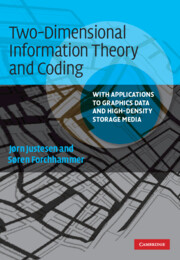 Two-Dimensional Information Theory and Coding
Two-Dimensional Information Theory and Coding Published online by Cambridge University Press: 05 June 2012
Introduction
Reed–Solomon codes are error-correcting codes defined over large alphabets. They were among the early constructions of good codes (1959), and are now one of the most important classes of error-correcting codes for many applications. At the same time these codes constitute a natural starting point for studying algebraic coding theory, i.e. methods of correcting errors by solving systems of equations.
Finite fields
To describe the codes and the decoding methods, the symbol alphabet is given a structure that allows computations similar to those used for rational numbers. The structure is that of a field. In a field there are two compositions, addition and multiplication, satisfying the usual associative and distributive rules. The compositions have neutral elements 0 and 1, every element has an additive inverse (a negative), and nonzero elements have a multiplicative inverse.
Well-known examples of fields include the rational, the real, and the complex numbers. The integers are not a field because only ±1 have multiplicative inverses. However, there are also fields with a finite number of elements, and we actually used the binary field in the previous chapter to construct binary codes. A finite field with q elements is referred to as F(q). Having the alphabet given this structure allows us to use concepts of matrices, vector spaces, and polynomials, which concepts are essential to the construction of codes and decoding algorithms.
The simplest examples of finite fields are sets of integers, [0, 1, 2, …, p − 1], with addition and multiplication modulo p.
To save this book to your Kindle, first ensure [email protected] is added to your Approved Personal Document E-mail List under your Personal Document Settings on the Manage Your Content and Devices page of your Amazon account. Then enter the ‘name’ part of your Kindle email address below. Find out more about saving to your Kindle.
Note you can select to save to either the @free.kindle.com or @kindle.com variations. ‘@free.kindle.com’ emails are free but can only be saved to your device when it is connected to wi-fi. ‘@kindle.com’ emails can be delivered even when you are not connected to wi-fi, but note that service fees apply.
Find out more about the Kindle Personal Document Service.
To save content items to your account, please confirm that you agree to abide by our usage policies. If this is the first time you use this feature, you will be asked to authorise Cambridge Core to connect with your account. Find out more about saving content to Dropbox.
To save content items to your account, please confirm that you agree to abide by our usage policies. If this is the first time you use this feature, you will be asked to authorise Cambridge Core to connect with your account. Find out more about saving content to Google Drive.